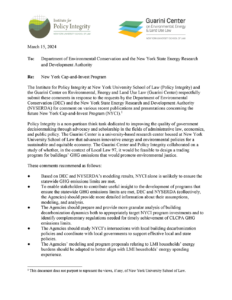The Guarini Center, together with the Institute for Policy Integrity (Policy Integrity), submitted comments to the New York State Department of Environmental Conservation (DEC) and New York State Energy Research and Development Authority (NYSERDA) in response to a request for comment on various recent publications and presentations concerning the future New York Cap-and-Invest Program (NYCI), including a Pre-Proposal Outline. The Pre-Proposal Outline and related modeling results were released by DEC and NYSERDA to help solicit input from stakeholders regarding the agencies’ development of rules to implement NYCI. NYCI is intended to help the state attain the greenhouse gas emissions limits set by the state’s Climate Leadership and Community Protection Act (CLCPA).
In the comments, the Guarini Center and Policy Integrity urge DEC and NYSERDA to:
- Proceed expeditiously with promulgating additional rules that ensure compliance with the CLCPA’s greenhouse gas (GHG) emissions limits, in view of the fact that NYCI alone is unlikely to ensure the statewide GHG emissions limits are met based on DEC and NYSERDA’s modeling results;
- Provide more detailed information about their assumptions, modeling, and analysis to enable stakeholders to contribute useful insight to the development of programs that ensure the statewide GHG emissions limits are met;
- Prepare and provide more granular analysis of building decarbonization dynamics both to appropriately target NYCI program investments and to identify complementary regulations needed for timely achievement of CLCPA GHG emissions limits;
- Study NYCI’s intersections with local building decarbonization policies and coordinate with local governments to support effective local and state policies;
- Adapt modeling and program proposals to better align with low- and middle-income households’ energy spending experience;
- Give the Public Service Commission clear direction on the magnitude of reductions needed in that sector, given infrastructure and institutional barriers to reducing GHG emissions associated with natural gas; and
- Implement measures that target the harm caused by co-pollutants to protect disadvantaged communities against disproportionate impacts.
For additional reading on this topic, see: The Road Ahead for New York Cap-and-Invest: Too Many GHG Emissions?
